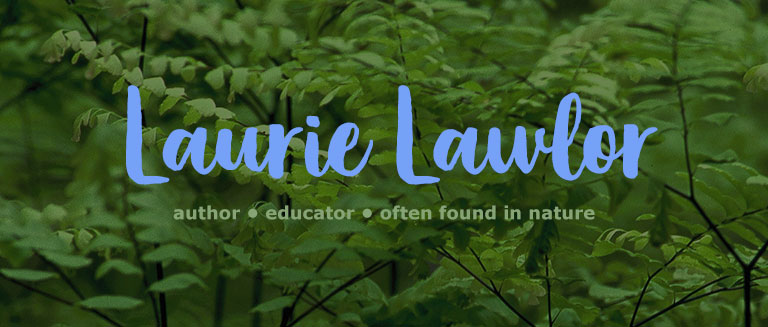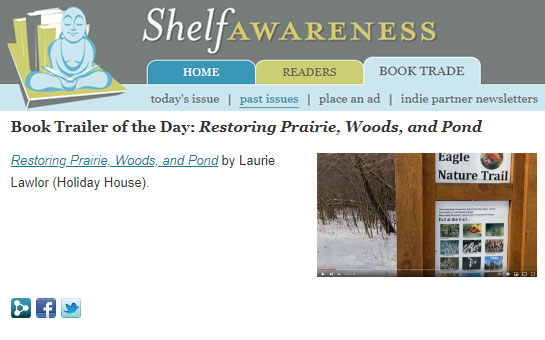How a Small Trail Can Make a Big Difference
Book Description
Restoring Prairie, Woods, and Pond: How a Small Trail Can Make a Big Difference is about activism at the community level—and tells how a small village in southeastern Wisconsin has transformed an eight-acre, municipally owned dumping ground and wasteland into a nature trail with three distinct ecosystems: a prairie, woodland, and ephemeral pond wetland. The trail runs from Eagle Elementary to the public library. Illustrated with color photos, the book explains how this trail has become a valuable outdoor classroom—even during COVID-19—a STEM teaching center, a respite for people young and old, and a place for community engagement.
One of the early turning points in the project came in spring 2010 when a few hardy volunteers trekked through the abandoned lot’s thick buckthorn and other invasives and discovered something remarkable: a few hardy native purple coneflowers and hoary vervain. This proved to be evidence of Eagle Prairie, what had once been the largest pre-settlement prairies in this part of Wisconsin. Frog song revealed another hidden gem: an almost inaccessible ephemeral pond—a rare wetland. Meanwhile, a few struggling woodland natives provided evidence of a small forest.
The forgotten wilderness wasn’t a dead zone after all.
With only a bare-bones budget, a group of volunteers—everyone from local firemen and high school students, to local business owners and Boy Scouts—came together to pitch in to clear invasives, cut buckthorn, grade the trail, and plant native prairie, woodland, and wetland species.
Honors and Recognition
- Blueberry Educators Resources 2023, Evanston Public Library
- Nature Generation Green Earth Book Awards shortlist
- Society of Midland Authors, Children’s Reading Roundtable Award for Children’s Nonfiction, Honor book
Resources
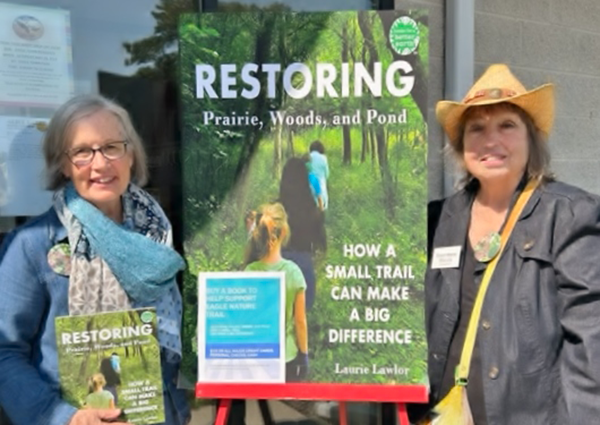 Laurie Lawlor and photographer Dawn-Marie Staccia pictured outside the Eagle Nature Trail Celebration, sponsored in part by the Alice Baker Memorial Library. 20 May 2023.
Laurie Lawlor and photographer Dawn-Marie Staccia pictured outside the Eagle Nature Trail Celebration, sponsored in part by the Alice Baker Memorial Library. 20 May 2023.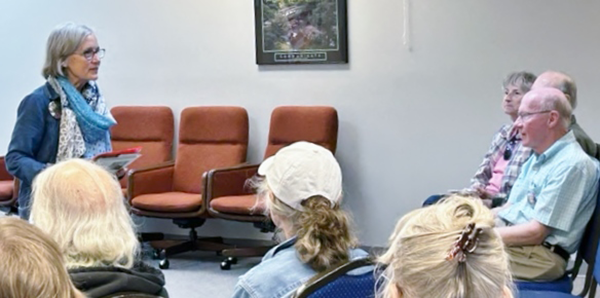 Eagle Nature Trail fundraiser, May 20, 2023, at Eagle Municipal Building in Eagle, WI. A lovely crowd of environmental enthusiasts from the community and beyond attended the book release. Book sale proceeds go toward present and future projects on Eagle Nature Trail.
Eagle Nature Trail fundraiser, May 20, 2023, at Eagle Municipal Building in Eagle, WI. A lovely crowd of environmental enthusiasts from the community and beyond attended the book release. Book sale proceeds go toward present and future projects on Eagle Nature Trail.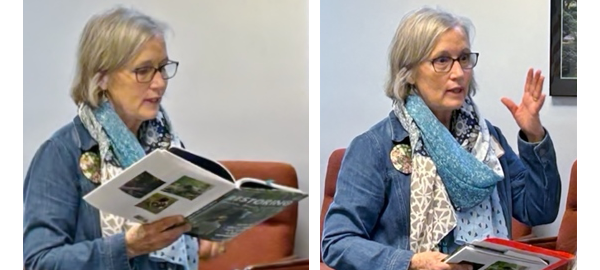 Laurie Lawlor reading aloud from Restoring Prairie, Woods, and Pond
Laurie Lawlor reading aloud from Restoring Prairie, Woods, and Pond Laurie Lawlor presented insights into creating Restoring Prairie, Woods, and Pond How a Small Trail Can Make a Big Difference, shared a reading, and provided autographs, bookmarks, and native seed packets.
Laurie Lawlor presented insights into creating Restoring Prairie, Woods, and Pond How a Small Trail Can Make a Big Difference, shared a reading, and provided autographs, bookmarks, and native seed packets.
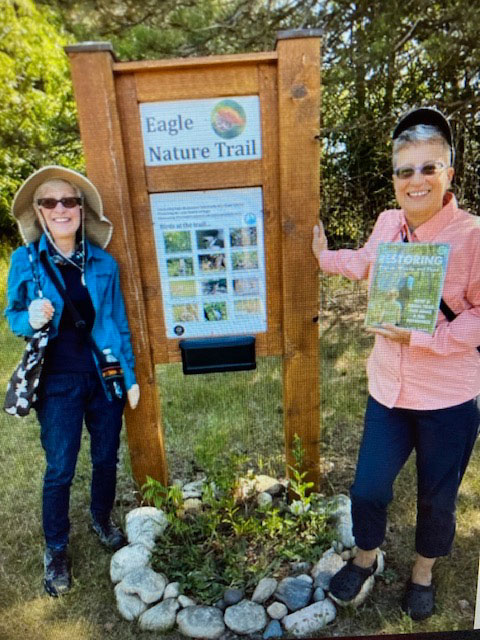
Still time to enjoy summer weather!
Intrepid eco-travelers from Evanston, IL Public Library, and members of the Blueberry Award Committee for great nature books for kids, Linda Bala and Martha Meyer, made a trip to Eagle Nature Trail, Eagle, WI, inspired by Restoring Prairie, Woods, and Pond: How a Small Trail Can Make a Big Difference.
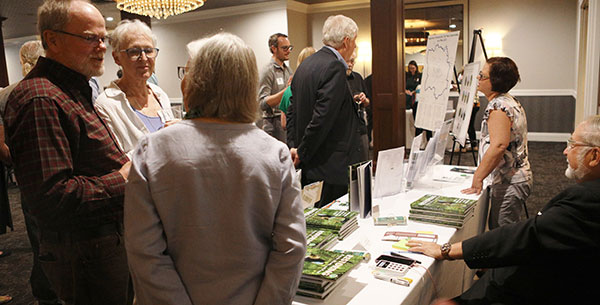 Waukesha County Land Conservancy’s annual meeting on May 31, 2023, in Delafield, Wisconsin, celebrated land and water protection.
Waukesha County Land Conservancy’s annual meeting on May 31, 2023, in Delafield, Wisconsin, celebrated land and water protection.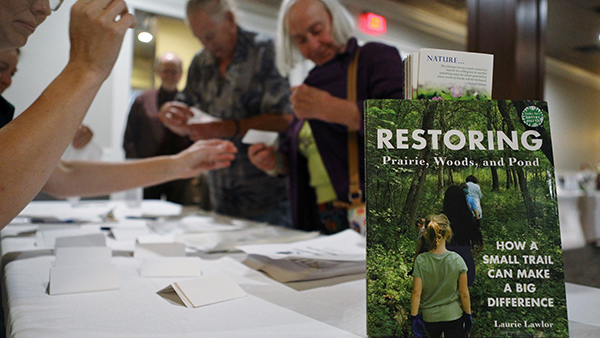 To date, this organization has helped protect 3,000 acres in Waukesha County.
To date, this organization has helped protect 3,000 acres in Waukesha County. Laurie Lawlor autographed Restoring Prairie, Woods, and Pond How a Small Trail Can Make a Big Difference, her recent book that profiles Eagle Nature Trail in Waukesha County.
Laurie Lawlor autographed Restoring Prairie, Woods, and Pond How a Small Trail Can Make a Big Difference, her recent book that profiles Eagle Nature Trail in Waukesha County.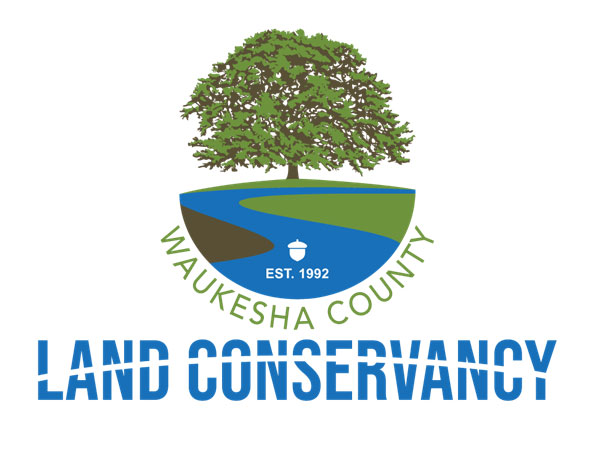 Waukesha County Land Conservancy
Waukesha County Land Conservancy
“Rewilding Ourselves: a Project of Hope [Midwest USA],” Laurie Lawlor, Rewilding Successes, 20 Mar 2024
“Author Laurie Lawlor explores nature in her latest book,” Jane Ammeson, NWI.com, 9 July 2023
Hear From the Author, Restoring Prairie, Woods, and Pond: How a Small Trail Can Make a Big Difference, Laurie Lawlor, originally published in The Prairie Promoter, a newsletter from The Prairie Enthusiasts, Vol. 36, No. 1, Spring 2023
“Books for a Better Earth Bloom at Holiday House,” Nathalie op de Beeck, Publishers Weekly, 23 March 2023
Delighted to find the Restoring Prairie book trailer featured in Shelf Awareness, Monday, April 24, 2023!
“Turning the Page on a Trail Restoration,” Kimberly Mackowski, The Park Next Door, 22 May 2023
Recommended in “Nature Scoop,” Toni Stahl, Habitat Ambassador, 25 May 2023
“Weedman awarded for efforts to restore abandoned lot into natural paradise,” Laurie Lawlor, Wild Ones Journal, Native Plants, Natural Landscapes, Summer 2023, Vol. 36, No. 2, page 22–23. With permission of Barbara A. Schmitz, Wild Ones Journal Editor.
“Local author looks to nature to inspire young readers,” Audrey Bodine, Evanston RoundTable, 14 June 2023.
Reviews and Comments
“More than a simple account of a wilderness restoration project. This is activism at its most accessible: the beautiful struggles of a region and community to make a large difference in a small world. A magical and timely story of ecosystems restored to their former glory.” (Kirkus Reviews, starred review)
“Many environmental books and stories are tales of woe; this one isn’t. Laurie Lawlor writes about a community project in Eagle, Wisconsin, that turned an eight-acre dumping ground into a nature trail for children. The Eagle Nature Trail organization includes Dave Traver, a library board member; Jean Weedman, an experienced prairie restorer; and a cadre of miracle-making volunteers.
Writing for middle grades and above, Lawlor provides an overview of the natural and cultural history of the land. This land was (and is) treasured by the Native Americans who were removed.
By the time the volunteers began to make the trail, the land was overgrown with invasive buckthorn, garlic mustard and more. Dumped chain-link fences, tires, shattered bottles and other junk littered the forest floor. Under the detritus, an ephemeral pond, prairie and woods seemed to await renewal. As volunteers cleared invasives, planted and sprouted, native trees and prairie plants took hold. The project began to bring joy and pride to the community, especially the children walking the trail between the elementary school and Alice Baker Memorial Library.
Lawlor includes specific stories of nature adventures in and around the trail. Children hurl milkweed pods to distribute seeds to make more habitats for monarchs and other pollinators. They learn about how frogs can enter a frozen dormancy in winter. Third-graders help plant prairie plants each spring. The changing seasons move plants and animals through colorful and exciting cycles of rebirth. This seasonal rebirth has seen an annual biodiversity increase since the initial 2010 plant inventory.
Find family lessons and activities for each season. Discover motivation to walk the trail. Be inspired to participate on any level. Plant native species in your yard or a pot on the porch. Participate in restoration projects in your community. Lawlor and the volunteers will inspire you.
European settlers, on the whole, didn’t value the natural systems in America. And they didn’t have a plan for wise use. When children learn to care for native species and systems, they become adults who will care for the planet. And — we need that.” (Amy Lou Jenkins, Wisconsin Sierra Club Magazine, 11 Sep 2023)
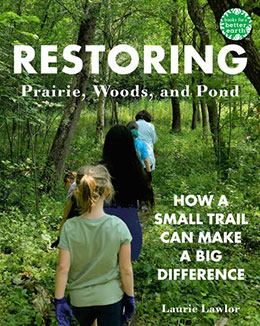
Books for a Better Earth series
written by Laurie Lawlor
Holiday House, April 2023

